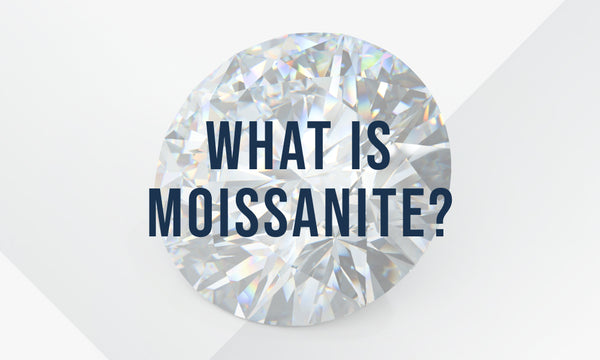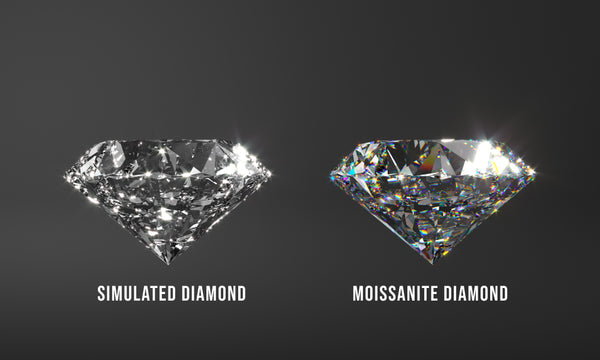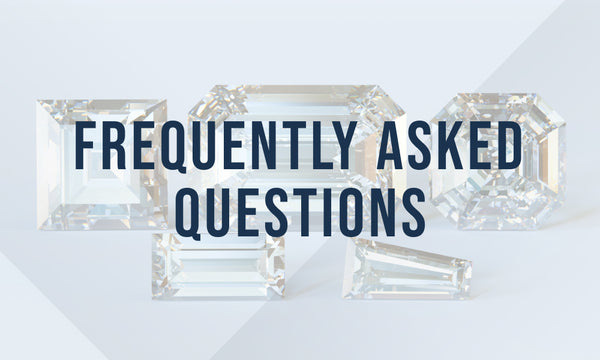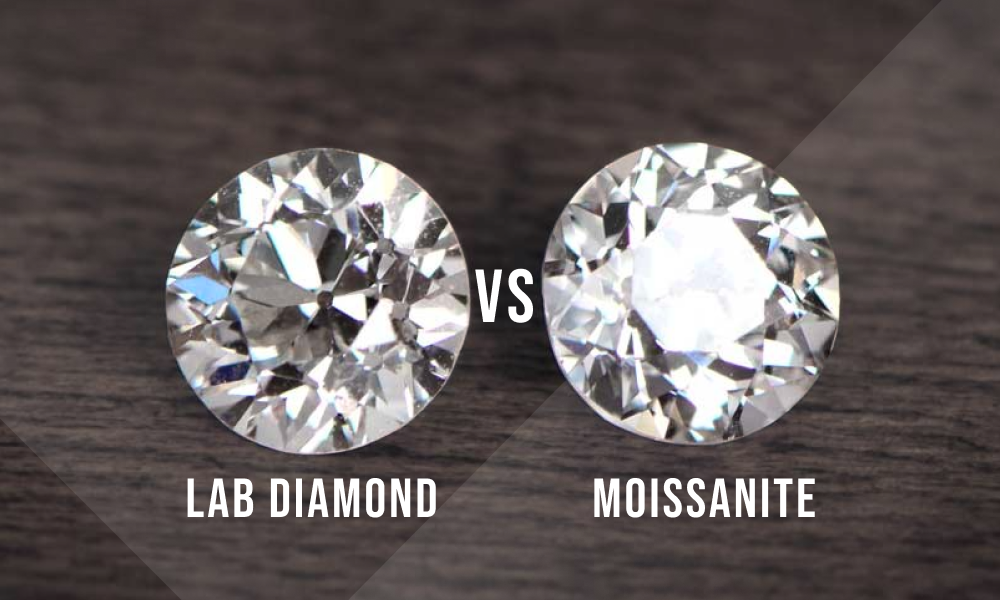Did you know there are several look-alike alternatives to natural diamonds? A diamond simulant is a diamond imitation exhibiting characteristics similar to a diamond.
Moissanite vastly differs in physical, chemical, and optical properties from diamond simulants. Moissanite is a high-quality synthetic version of natural moissanite, not a natural diamond or other stones taking the place of a diamond.
This side-by-side comparison of simulated diamonds and moissanite provides an in-depth look at the pros and cons of each, helping you make the best decision when purchasing jewelry.
What is a Simulated Diamond?

Simulated vs. synthetic diamonds and lab diamond vs. moissanite: what makes these stones unique? Simulants should not be confused with lab-grown diamonds, which are man-made diamonds with the same optical, physical, and chemical properties of natural diamonds. Simulants refers to a wide range of materials taking the place of a diamond for different reasons.
Affordability and desire for another stone is paramount when purchasing something other than a natural or lab-grown diamond. Eco-friendly and sustainability are also key factors that make diamond simulants so appealing.
How are Diamond Simulants Created
A common diamond simulant is man-made cubic zirconia, a budget-friendly diamond alternative made by melting powdered zirconium with zirconium dioxide in metal chambers. The melt is then slowly moved away from its heat source, allowing the crystals to form on the bottom of the melt until fully solidified. Heating this mixture in extreme temperatures forms crystals ready for cutting and faceting. Cubic zirconia “CZ” was introduced to the market in the 1970s and remains incredibly popular today–it is a lab-created version of natural cubic zirconia discovered in the 1930s.
Gadolinium Gallium Garnet (GGG) is a synthetic stone used to substitute diamonds, invented in the 1960s. GGG is manufactured using the Czochralski method and can be produced in colorless "white" and fancy colors.
Yttrium Aluminum Garnet (YAG) is a synthetic crystalline of the garnet group also used as a substitute for diamonds with a chemical composition of Y3Al5O12. YAG is considered a classic simulant like glass, natural zircon, and colorless synthetic spinel (GIA) and is rarely used today because there are now better diamond simulant alternatives.
Strontium Titanate is a synthetic diamond simulant composed of oxide of strontium and titanium with the chemical formula SrTiO3. Strontium titanate was invented in the 1950s, displaying spectacular fire and brilliance that exceeds a diamond. Strontium titanate was marketed under trade names like Diagem and Fabulit, enticing the customer.
Synthetic Spinel is the man-made version of natural spinel. Synthetic spinel is a budget-friendly simulant used in place of diamonds and semi-precious/precious gemstones often utilized in class rings and birthstone jewelry creations. Synthetic spinel exhibits richly saturated hues and sparkling icy-white color.
Crystal (Glass) is one of the oldest gem imitations popular in current fashion jewelry. Glass can be faceted and cut into a rainbow of colors, making it a budget-friendly substitute for diamonds and gems. Glass can imitate amethyst, citrine, tiger's eye, turquoise, opal, diamonds, and so much more! Foiled backs of glass produce rhinestones. Swarovski brand developed lead-free crystal that is lead-free, offering an incredibly brilliant stone that is also environmentally friendly.
Plastic is even less durable than glass but is still commonly used in fashion jewelry. This inexpensive material is also created into pearl, amber, coral, jade, turquoise, and lapis simulants (GIA).
What is Moissanite?

In 1893, Nobel Prize-winning chemist Dr. Henri Moissan discovered natural moissanite in Arizona (hence the name moissanite). Natural moissanite is actually quite rare and expensive, found in the upper mantle rock and meteorites (Gem Society). Moissanite is even rarer than diamonds! Moissanite is classified as a diamond simulant because it is used in the place of a diamond but is quite different from other diamond simulants.
How is Moissanite Created?
Moissanite refers to synthetic or lab-created moissanite. Production for lab-grown moissanite started in the 1990s by scientists. Moissanite is composed of silicon carbide (SiC), with a carbon atom surrounded by four silicon atoms in a tetrahedral form. Moissanite is formed using a combination of pressure and heat, created in an identical structure to natural moissanite. It can take between 2-3 months to produce a gem through a long, arduous process.
What Are the Differences Between Simulated Diamond and Moissanite?
There are many differences between simulated diamond and moissanite. Here are some of their attributes, comparing them.
Sparkle
Sparkle is defined as alternating flashes of white and spectral-colored light, contrasting the dark and light that moves around the stone. A diamond's famous sparkle is called scintillation.
Some diamond simulants have a lot less sparkle than diamonds and moissanite. Glass and plastic have low brilliance, appearing flat and dull when set side by side with a diamond. Moissanite has undeniable brilliance and fire, making it a truly unique option for those seeking a diamond alternative while purchasing jewelry.
Ideal Size
The ideal size of the stone depends on the style and budget-friendly preference. The ideal size often accompanies standard measurements, appearing as suitably symmetrical or diameter. The ideal size relates to the ideal cut, part of the diamond’s 4Cs (color, clarity, cut, and caratage) when determining the worth of the stone.
Wear and Tear
Certain stones are known abrading or showing signs of wear and tear along the facet junctions over time. Glass and plastic can abrade easily when worn frequently, knocked, dropped, or exposed to harsh environmental factors. However, they are the perfect choices for low-priced jewelry and accessory fashion trends that come and go.
Strontium Titanate shows visible signs of wear and tear with chips and abraded facet junctions due to its low 5.5 Mohs scale rating. YAG may lose its sparkle and abrade over time, along with synthetic spinel and GGG. Moissanite is durable and hard, replacing GGG, YAG, and Strontium Titanate as a popular diamond alternative suitable for frequent wear.
Refractive Index
The refractive index (fire) measures the bending of a ray of light when passing from one medium into another (Britannica). Diamond has a refractive index of 2.417, giving it an admirable fire. The higher the refractive index, the more fire is displayed.
Comparisons of diamond simulants and moissanite:
Material Refractive Index
Moissanite 2.65-2.69
Diamond 2.417
Strontium Titanate 2.409
Cubic Zirconia 2.15-2.18
GGG 1.97-2.03
YAG 1.833
Synthetic spinel 1.710 to 1.735+
Glass 1.50
Plastic 1.30-1.60
Moissanite has a refractive index of 2.65 to 2.69 with an adamantine to metallic luster, making it the world's most brilliant gemstone--more brilliant than diamond and other diamond simulants. Moissanite also displays highly dispersive double refractivity (fire).
Durability
The Mohs Hardness Scale is a scale from 1-10 used to determine the relative hardness of minerals and other objects. The hardness relates to the durability of the stone–more durable stones that are higher on the scale become more scratch resistant.
Material Hardness
Diamond 10
Moissanite 9.25
Synthetic Spinel 8
Cubic Zirconia 8-8.5
YAG 8.5
GGG 6.50
Glass 5.5-7
Strontium Titanate 5.5
Plastic 2.50
Color & Clarity
Moissanite is graded using the 4C’s diamond grading scale developed by the Gemological Institute of America (GIA). The 4Cs include color, cut, clarity, and caratage relating to the overall value and quality of the stone.
If there is a quality assessment for cubic zirconia, there may be the AAAA, AAA, AA, A quality scale, with AAAA notating the higher quality stone. Cubic zirconia rarely, if ever, contains inclusions.
Other diamond simulants may contain inclusions, such as YAG, GGG, and Strontium Titanate, telling the tale of their laboratory origins. Glass, plastic, and synthetic spinel are not a part of this grading process.
Most diamond simulants are available in a rainbow of colors, including popular colors such as green, yellow, pink, and blue. Moissanite can also be made into fancy colors ranging from faint to vivid.
Pricing
Moissanite is a more affordable, higher-quality alternative to diamonds with uniquely beautiful attributes. According to Brides, moissanite is approximately 1/10 the cost of a mined diamond of equal size and quality. These price-friendly options allow the consumer to choose the ring they want, making your dream engagement ring or hip hop jewelry well within reach.
So Which is Better, Simulated Diamond vs. Moissanite?

Simulated stone vs. moissanite: which is your best choice? Natural diamonds may command higher price points depending on the quality and caratage. Lab-grown diamonds are more affordable substitutes for diamonds, but may also have lower resale value when compared to their natural counterparts. Synthetic spinel and cubic zirconia are synonymous with fashion jewelry. GGG, YAG, and Strontium Titanate are becoming considerably less and less common because of the popularity of moissanite, a durable diamond alternative.
Who Should Pick a Simulated Diamond?
There are some beautiful alternatives, such as the Sona simulated diamond. When contemplating designer brands, which is better, a Sona simulated diamond vs. moissanite? Sona is an affordable alternative with precise cuts but does not take the place of a diamond or moissanite. It is a stunning substitute with its positive attributes. When it comes to comparing Sona diamond vs. moissanite, both stones have different optical, chemical, and physical properties.
Class rings, fun stacking rings, glittering tiaras, accessories, and so much more contain simulated diamond material, creating a glam and bold appearance. Popular today, forgotten tomorrow, simulated diamonds are the perfect indulgence for any fleeting fashion.
Who Should Pick Moissanite?
Moissanite provides a fantastic substitute for diamonds over other diamond simulants for those purchasing fine jewelry or investment pieces. Moissanite is prevalent, making it easy to create your ring through website interfaces or by choosing one already made and assembled. Moissanite is a uniquely brilliant stone that is durable, sparkly, gorgeous, and timeless, set into premium gold, platinum, or silver.
Frequently Asked Questions

1. Where to buy moissanite rings?
Moissanite is prevalent, making it easy to create your ring through website interfaces or by choosing one already made and assembled. Moissanite is a uniquely brilliant stone that is durable, sparkly, gorgeous, and timeless, set into premium gold, platinum, or silver.
2. How hard is moissanite?
Moissanite is very hard, rating a 9.25 out of 10 (diamond) on the Mohs scale.
3. Does simulated moissanite pass the diamond tester?
Moissanite is an effective conductor of heat and will pass as a diamond with a diamond tester if it is tested with a diamond tester that discovers thermal conductivity.
Final Thoughts
Summary: When it comes to simulated stone vs. moissanite, this includes popular options such as cubic zirconia, glass, plastic, and synthetic spinel. These diamond simulants are perfect for fashion jewelry or affordable creations.
Recommendation on simulated diamonds vs. moissanite: Although there are different simulated diamonds available, they do not take the place of a diamond. Moissanite is a high-quality, socially conscious alternative to natural diamonds, set into fine jewelry of value.



































































